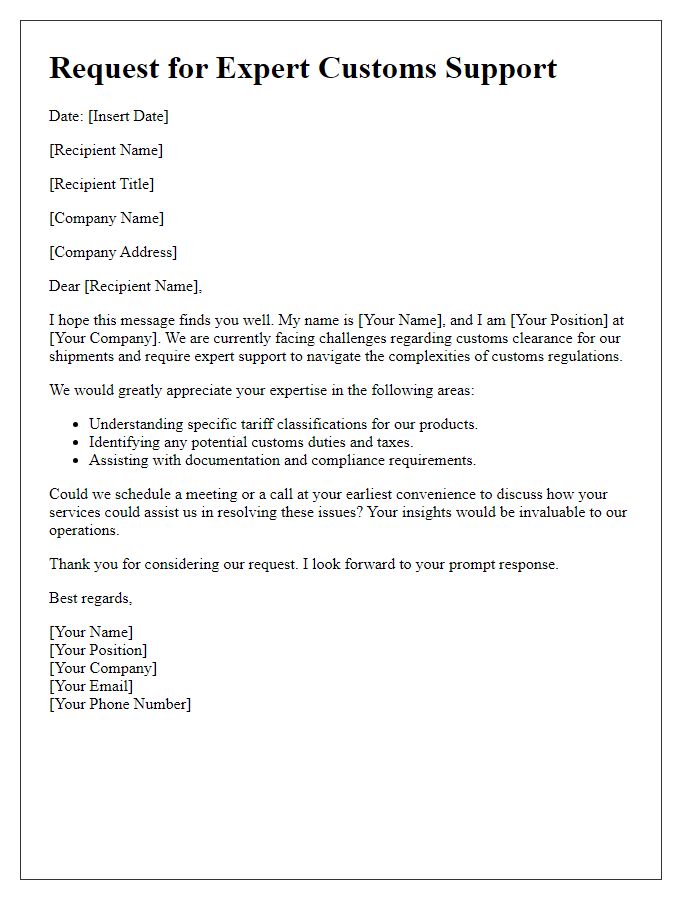Are you navigating the often complex world of customs clearance? It can feel overwhelming, but having the right support can make all the difference in ensuring a smooth process. In this article, we'll provide you with a handy letter template specifically designed to assist you in communicating with customs officials effectively. Dive in and discover how you can streamline your customs experience!

Complete shipping details
Customs clearance support requires comprehensive shipping details to ensure compliance with international trade regulations. Shipping documents must include the invoice, detailing product descriptions, quantities, and values in US dollars, along with the Harmonized System (HS) codes specific to each item, enabling customs authorities to classify and assess duties accurately. The bill of lading, issued by carriers like FedEx or DHL, serves as proof of shipment, listing the sender (exporter), recipient (importer), and shipping route. Also, necessary permits and certificates -- such as phytosanitary or import licenses -- could be required depending on the type of goods. Consignee information should reflect the importing entity, including a valid tax identification number, to facilitate smooth customs operations. Accurate and complete paperwork enhances the likelihood of timely clearance and reduces the potential for costly delays.
Accurate product description
Accurate product descriptions play a crucial role in customs clearance processes, influencing the speed and efficiency of the import and export of goods. Detailed information about the product, including its specifications, intended use, and material composition, facilitates compliance with international trade regulations. For example, electronic devices require precise classifications under HS codes, which determine tariff rates and customs duties. Providing additional data, such as country of origin, manufacturer details, and quantity (in units like kilograms or liters), can further streamline interactions with customs officials at ports such as Los Angeles or Rotterdam. Clear product descriptions also assist in identifying any applicable trade agreements or restrictions, thus minimizing delays and ensuring adherence to global import regulations.
Harmonized System (HS) codes
The Harmonized System (HS) codes play a crucial role in international trade, categorizing products for customs clearance processes. These six-digit numerical codes, established by the World Customs Organization, standardize the classification of traded goods globally. For example, HS code 8443 pertains to printing machinery, which includes various types of equipment used in the printing industry. Proper identification of HS codes ensures compliance with tariff regulations and simplifies customs procedures at international borders, such as those in the United States or the European Union. Accurate classification aids in determining applicable duties, taxes, and trade restrictions, ultimately streamlining logistics and reducing delays in the supply chain.
Customs broker contact information
Customs brokers play a vital role in the logistics and trade process, ensuring smooth customs clearance for imported and exported goods. A customs broker typically provides contact information, including the broker's name, company name, address (often located within proximity to major ports such as Los Angeles or New York), phone number, and email address, creating an essential support network for businesses navigating complex regulations. They assist with the preparation and submission of required documentation, including invoices, certificates of origin, and customs declarations, ensuring compliance with local laws and international standards. Engaging a proficient customs broker streamlines the process of clearing shipments while minimizing delays and avoiding potential fines, thereby facilitating efficient trade operations.
Authorization and signature
Customs clearance requires precise documentation and authorization to facilitate the entry or exit of goods across international borders. A customs clearance support letter typically includes identifying details of the shipping company, consignment specifics, and all relevant parties involved. Essential components often entail explicit authorization for agents to act on behalf of the shipper, clear identification of goods being transported, and signatures from authorized personnel signifying agreement and compliance with local and international trade regulations. Notably, accurate completion of this document can prevent delays and ensure smooth processing through customs facilities.













Comments